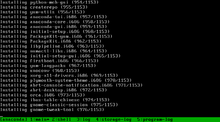Anaconda (installer)
|
Anaconda's installation screen for Fedora 19 | |
| Developer(s) | Anaconda Team |
|---|---|
| Initial release | 1999 |
| Repository |
github |
| Development status | Active |
| Written in | Python and C |
| Operating system | МТ |
| Available in | Multilingual |
| Type | Installer |
| License | GPL (Free software) |
| Website |
fedoraproject |

Anaconda is the installer for Red Hat Enterprise Linux, Oracle Linux, Scientific Linux, CentOS and Fedora.
Functionality
Anaconda offers a text-mode and GUI mode, so users can install on a wide range of systems. It is designed to be easily portable and supports a wide range of hardware platforms (IA-32, Itanium, DEC Alpha, IBM ESA/390, PowerPC, ARMv8). It supports installing from local storage devices like CD-ROM drives and harddisks as well as from network resources via FTP, HTTP, or NFS. Installations can be automated with the use of a kickstart file, that automatically configures the installation, allowing users to run it with minimal supervision. Before beginning installation of the OS, installer checks the hardware requirement and all the resources of that system. If requirements are satisfied, then begins the installation process.
Technology
It is mainly written in Python with some modules written in C. It has a graphical frontend that is based on GTK+ 3/PyGObject and designed with the Glade Interface Designer. Anaconda also has a custom text frontend with support for computers with line printer like terminals, such as the IBM ESA/390 mainframes.
Availability and usage
It is available as free software under the terms of the GNU General Public License (GPL).
Anaconda installer is used by RHEL, Fedora and a number of other projects.[1]
